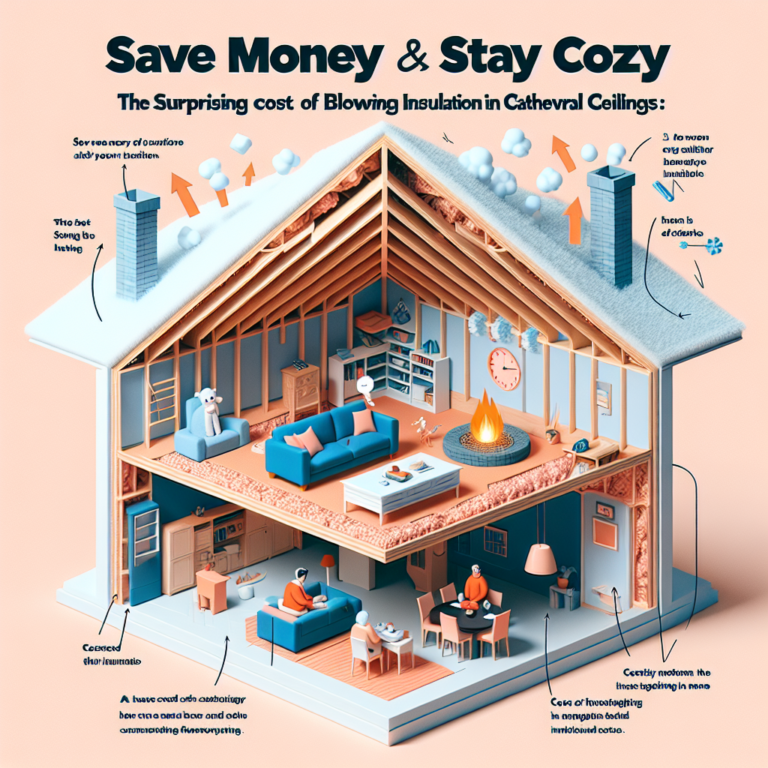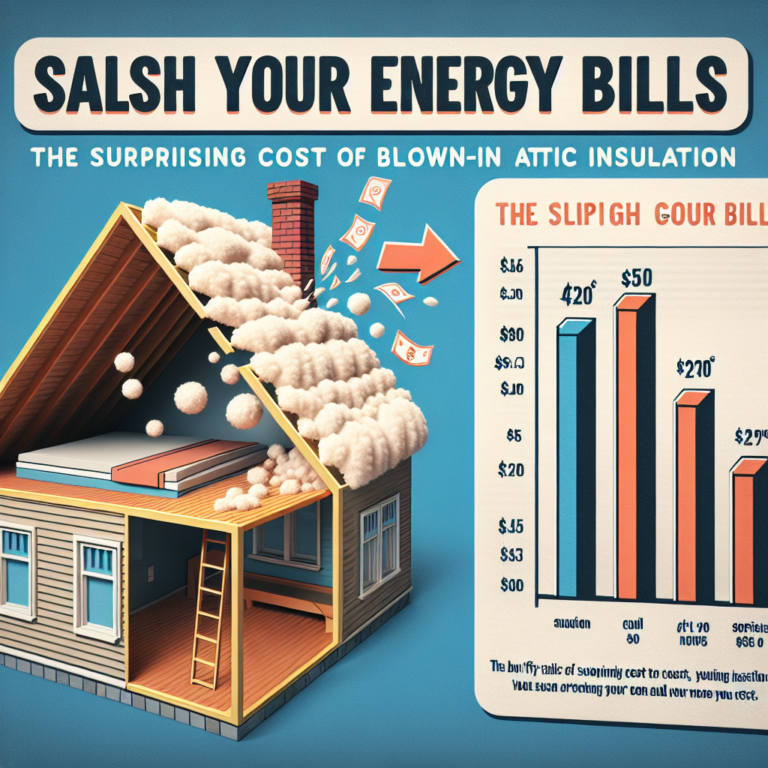-
Table of Contents
Upgrade your HVAC system with high-quality blown-in insulation for optimal comfort and energy efficiency.
Upgrade your HVAC system with high-quality blown-in insulation for improved energy efficiency and cost savings. Visit texasinsulationsolution.com to learn more and schedule your installation today.”
Introduction
Your HVAC system is an essential component of your home, responsible for keeping you comfortable and maintaining a consistent temperature. However, without proper insulation, your HVAC system may struggle to perform efficiently and effectively. This is where high-quality blown-in insulation comes in. In this introduction, we will discuss the importance of having high-quality blown-in insulation for your HVAC system and the benefits it can provide.
Benefits of High-Quality Blown-In Insulation for Your HVAC System
When it comes to maintaining a comfortable and energy-efficient home, the quality of your HVAC system is crucial. However, many homeowners overlook the importance of insulation in their HVAC system. Insulation plays a significant role in keeping your home at a comfortable temperature and reducing energy costs. While there are various types of insulation available, blown-in insulation stands out as one of the most effective options. In this article, we will discuss the benefits of high-quality blown-in insulation for your HVAC system.
First and foremost, blown-in insulation is known for its superior insulating properties. Unlike traditional insulation, which comes in pre-cut sheets or rolls, blown-in insulation is made up of small particles that are blown into the desired space. This allows for a more thorough and even distribution of insulation, leaving no gaps or spaces for air to escape. As a result, your HVAC system will not have to work as hard to maintain a consistent temperature, leading to lower energy bills.
Moreover, blown-in insulation is highly versatile and can be used in various areas of your home. It can be blown into walls, attics, and crawl spaces, making it an ideal choice for both new construction and existing homes. This versatility allows for a more comprehensive insulation solution, ensuring that your entire home is well-insulated and energy-efficient.
Another significant benefit of blown-in insulation is its ability to reduce noise levels in your home. The small particles of insulation act as a sound barrier, absorbing and reducing noise from outside sources. This is especially beneficial for homes located in busy or noisy areas. Additionally, blown-in insulation can also help reduce noise levels within your home, making it a more peaceful and comfortable living space.
One of the most significant advantages of blown-in insulation is its eco-friendliness. This type of insulation is made from recycled materials, such as shredded newspaper or cellulose fibers. By using blown-in insulation, you are not only reducing your energy consumption but also contributing to a more sustainable environment. Furthermore, blown-in insulation is non-toxic and does not contain any harmful chemicals, making it safe for both your family and the environment.
In addition to its insulating properties, blown-in insulation also acts as a barrier against moisture. Moisture can be a significant issue in homes, leading to mold growth and structural damage. Blown-in insulation creates a tight seal, preventing moisture from seeping into your home. This can help improve the air quality in your home and protect your HVAC system from potential damage.
Lastly, blown-in insulation is a cost-effective option for homeowners. Its installation process is quick and efficient, requiring minimal labor and time. This means that you can save on installation costs and enjoy the benefits of blown-in insulation sooner. Additionally, its long lifespan and energy-saving properties can lead to significant savings on your energy bills in the long run.
In conclusion, blown-in insulation offers numerous benefits for your HVAC system. Its superior insulating properties, versatility, noise reduction, eco-friendliness, moisture resistance, and cost-effectiveness make it a top choice for homeowners. By investing in high-quality blown-in insulation, you can improve the efficiency and longevity of your HVAC system, creating a more comfortable and sustainable living space for you and your family.
How Sugar Land Insulation Services Can Improve Your HVAC Efficiency
When it comes to keeping your home comfortable and energy-efficient, your HVAC system plays a crucial role. However, many homeowners overlook the importance of proper insulation in their HVAC system. Insulation is a key component in maintaining the efficiency of your HVAC system, and blown-in insulation is a popular choice for many homeowners in Sugar Land. In this article, we will discuss why your HVAC system needs high-quality blown-in insulation and how Sugar Land insulation services can improve your HVAC efficiency.
First and foremost, let’s understand what blown-in insulation is and how it works. Blown-in insulation is a type of insulation that is made up of small particles of materials such as fiberglass, cellulose, or mineral wool. These particles are blown into the walls, attic, or crawl spaces of a home using a special machine. The insulation fills up any gaps or spaces, creating a barrier that prevents heat transfer. This means that during the hot summer months, the insulation will keep the cool air inside your home, and during the cold winter months, it will keep the warm air inside.
One of the main reasons why your HVAC system needs high-quality blown-in insulation is to improve its efficiency. Without proper insulation, your HVAC system has to work harder to maintain the desired temperature in your home. This not only puts a strain on your system but also leads to higher energy bills. With blown-in insulation, your HVAC system doesn’t have to work as hard, as the insulation helps to regulate the temperature in your home. This results in lower energy bills and a more efficient HVAC system.
Moreover, blown-in insulation also helps to reduce noise levels in your home. The insulation acts as a sound barrier, absorbing and reducing noise from outside sources. This is especially beneficial for homes located near busy roads or in noisy neighborhoods. With blown-in insulation, you can enjoy a quieter and more peaceful home environment.
Another advantage of blown-in insulation is that it is a cost-effective solution. Unlike other types of insulation, such as batt insulation, blown-in insulation can be installed quickly and easily. This means that you won’t have to spend a lot of money on labor costs. Additionally, blown-in insulation is made from recycled materials, making it an environmentally friendly option. It also has a longer lifespan compared to other types of insulation, which means you won’t have to replace it as often, saving you money in the long run.
Now that we understand the benefits of blown-in insulation, let’s discuss how Sugar Land insulation services can improve your HVAC efficiency. Professional insulation services have the expertise and equipment to properly install blown-in insulation in your home. They will ensure that the insulation is evenly distributed and reaches all the nooks and crannies, providing maximum coverage and efficiency. They will also use high-quality materials, ensuring that your insulation will last for years to come.
In addition to installation, Sugar Land insulation services also offer maintenance and repair services. Over time, insulation can become compressed or damaged, reducing its effectiveness. Insulation services can inspect and repair any issues, ensuring that your HVAC system continues to run efficiently.
In conclusion, blown-in insulation is a crucial component in maintaining the efficiency of your HVAC system. It not only helps to regulate the temperature in your home but also reduces noise levels and saves you money on energy bills. With the help of Sugar Land insulation services, you can ensure that your HVAC system is running at its best and providing you with a comfortable and energy-efficient home.
The Importance of Proper Insulation for Your HVAC System: A Guide for Homeowners
As a homeowner, you may not give much thought to the insulation in your home. However, proper insulation is crucial for maintaining a comfortable and energy-efficient living space. This is especially true when it comes to your HVAC system, which is responsible for heating and cooling your home. In this guide, we will discuss the importance of high-quality blown-in insulation for your HVAC system and why it should not be overlooked.
First and foremost, let’s define what blown-in insulation is. It is a type of insulation that is made up of loose fibers or particles, such as fiberglass, cellulose, or mineral wool. These materials are blown into the walls, attic, or other areas of your home using a special machine. This method allows for a more even distribution of insulation, filling in any gaps or voids that may exist.
Now, you may be wondering why blown-in insulation is necessary for your HVAC system. The answer lies in its ability to prevent heat transfer. In the winter, insulation helps to keep the warm air inside your home, while in the summer, it keeps the hot air out. This means that your HVAC system does not have to work as hard to maintain a comfortable temperature, resulting in lower energy bills.
But why does the quality of the insulation matter? The quality of insulation is determined by its R-value, which measures its resistance to heat flow. The higher the R-value, the better the insulation is at preventing heat transfer. This is where blown-in insulation shines. It has a higher R-value compared to other types of insulation, making it more effective in keeping your home comfortable and energy-efficient.
Another benefit of blown-in insulation is its ability to fill in small spaces and gaps. This is especially important for your HVAC system, as air leaks can significantly impact its efficiency. With blown-in insulation, these gaps and spaces are filled, creating a more airtight seal. This not only helps your HVAC system but also improves the overall energy efficiency of your home.
Furthermore, blown-in insulation is a more eco-friendly option compared to other types of insulation. It is made from recycled materials and does not contain harmful chemicals. This means that not only are you improving the energy efficiency of your home, but you are also reducing your carbon footprint.
In addition to its energy-saving benefits, blown-in insulation also has soundproofing properties. It can help reduce noise from outside, making your home a quieter and more peaceful place. This is especially beneficial for those living in noisy neighborhoods or near busy roads.
Now that we have established the importance of high-quality blown-in insulation for your HVAC system, let’s discuss the installation process. It is recommended to hire a professional to install blown-in insulation, as it requires specialized equipment and expertise. A professional will ensure that the insulation is evenly distributed and properly installed, maximizing its effectiveness.
In conclusion, blown-in insulation is a crucial component of your HVAC system. It helps to maintain a comfortable and energy-efficient living space, reduces noise, and is environmentally friendly. Its high R-value and ability to fill in small spaces make it a superior choice compared to other types of insulation. So, if you want to improve the efficiency of your HVAC system and save on energy bills, consider investing in high-quality blown-in insulation.
Q&A
1) What is blown-in insulation and how does it benefit an HVAC system?
Blown-in insulation is a type of insulation material that is installed by blowing it into walls, attics, and other spaces using specialized equipment. It is typically made of materials such as fiberglass, cellulose, or mineral wool. Blown-in insulation helps to improve the energy efficiency of an HVAC system by reducing heat loss or gain, which can result in lower heating and cooling costs.
2) How does high-quality blown-in insulation differ from other types of insulation?
High-quality blown-in insulation is typically made of denser and more durable materials, which allows it to provide better insulation and last longer. It is also installed using specialized equipment, ensuring a more thorough and even distribution throughout the space. This can result in better overall energy efficiency and a more comfortable indoor environment.
3) What are some signs that your HVAC system may need high-quality blown-in insulation?
Some signs that your HVAC system may benefit from high-quality blown-in insulation include uneven temperatures throughout your home, high energy bills, and drafts or cold spots in certain areas. Additionally, if your HVAC system is constantly running or struggling to maintain a consistent temperature, it may be a sign that your insulation is not providing enough thermal resistance. In these cases, upgrading to high-quality blown-in insulation can help improve the efficiency and performance of your HVAC system.
Conclusion
In conclusion, high-quality blown-in insulation is essential for any HVAC system. It helps to improve energy efficiency, reduce utility costs, and maintain a comfortable indoor temperature. It also helps to prevent air leaks and moisture buildup, which can lead to costly repairs and health hazards. Investing in high-quality blown-in insulation is a wise decision that can benefit both your HVAC system and your overall home comfort.






